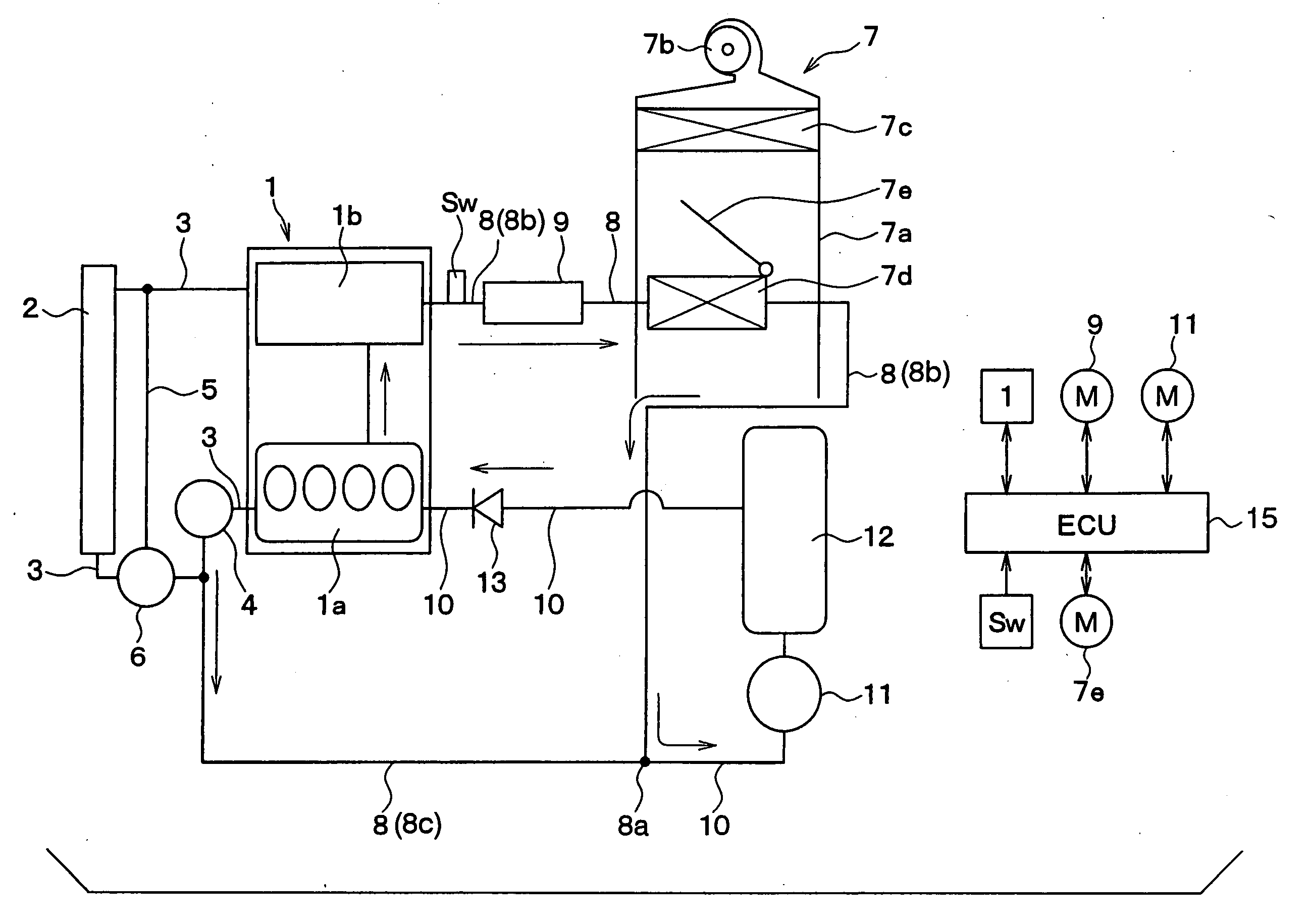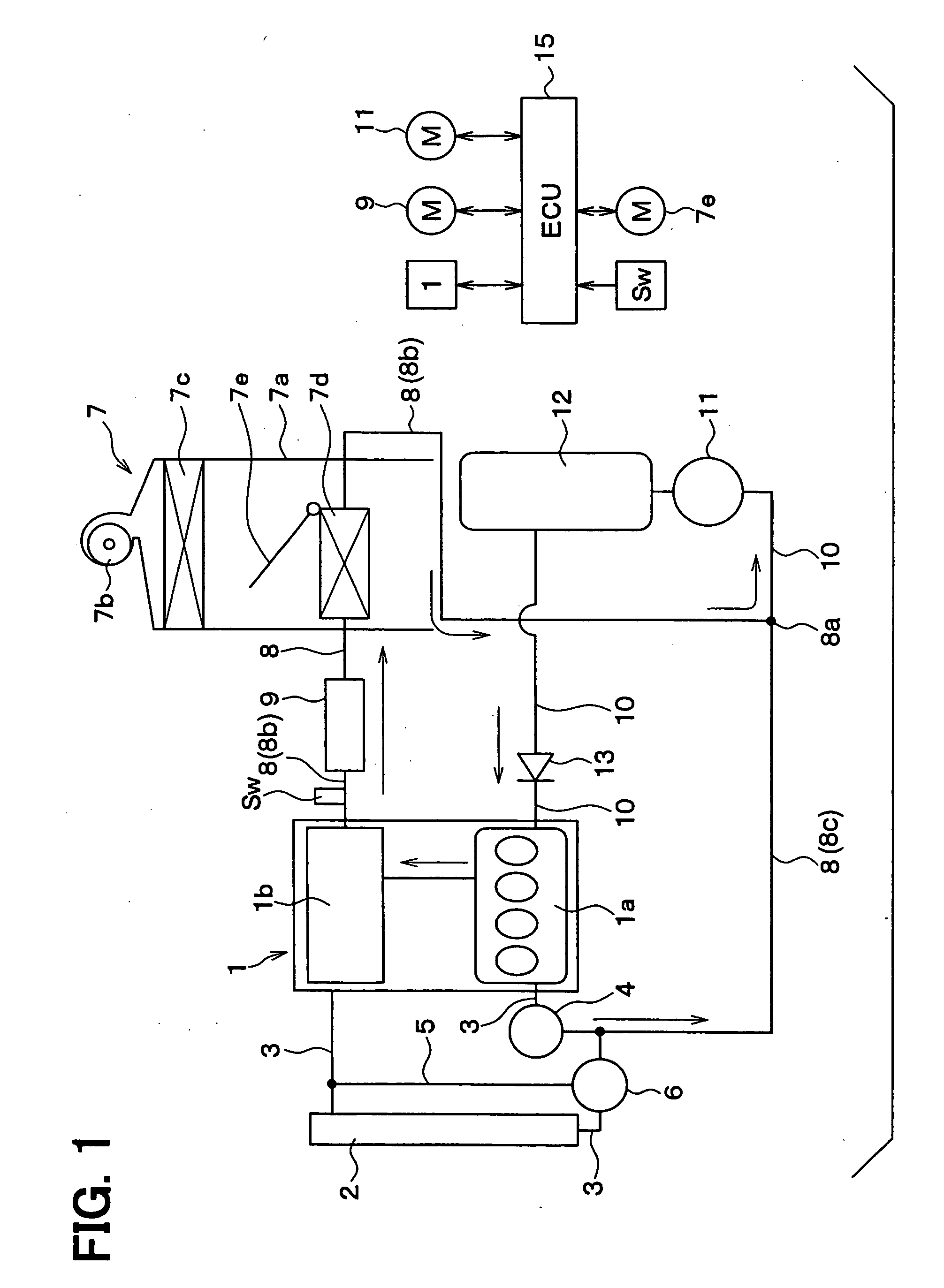Waste heat utilizing system
a technology of utilizing system and waste heat, which is applied in the direction of engine starters, lighting and heating apparatus, heating types, etc., can solve the problems of high cost, reduced service life, and reduced service life of engine cooling water, so as to achieve low cost
- Summary
- Abstract
- Description
- Claims
- Application Information
AI Technical Summary
Benefits of technology
Problems solved by technology
Method used
Image
Examples
first embodiment
[0033] A first embodiment of the present invention will be explained. FIG. 1 shows a schematic system structure for a waste heat utilizing system for an automotive engine according to a first embodiment of the present invention, whereas FIG. 2 is a table showing various operational modes of the system shown in FIG. 1.
[0034] In FIG. 1, an internal combustion engine 1 produces a driving power for driving a vehicle, wherein the engine operation is automatically stopped when a certain operational condition for an engine stop is met, whereas the engine operation is automatically re-started when a certain operational condition for an engine re-start is satisfied. For example, the engine operation is stopped when the vehicle temporally stops due to a red traffic lamp, and re-started when a vehicle driver operates the vehicle to move again.
[0035] The engine 1 is a water cool type engine, in which a water jacket (not shown) is formed in a cylinder block 1a and a cylinder head 1b for circul...
second embodiment
[0071] A second embodiment of the present invention will be explained. FIG. 6 shows a schematic system structure for a waste heat utilizing system for an automotive engine according to a second embodiment of the present invention, whereas FIG. 7 is a table showing various operational modes of the system shown in FIG. 6.
[0072] In the second embodiment, the two-way valve 9 of the first embodiment is eliminated. As shown in FIG. 7, however, the operational modes of the second embodiment (the operational conditions of the engine 1 and the second pump 11) are the same to those of the first embodiment (FIG. 2).
[0073] The fluid flow of the engine cooling water in the circulation mode in the engine warm-up operation is different from that of the first embodiment, because the two-way valve 9 of the first embodiment is eliminated in this second embodiment.
[0074]FIG. 6 shows the fluid flow of the engine cooling water in the circulation mode of the engine warm-up operation. The engine coolin...
third embodiment
[0078] A third embodiment of the present invention will be explained with reference to FIGS. 8 to 13. A system structure of the third embodiment differs from the first embodiment, in that the check valve 13 for allowing the engine cooling water to flow only in one direction (the direction of the pumped out water by the second pump 11) is provided in the heat storage tank 12, and an ON-OFF valve 14 is provided in parallel with the check valve 13 for opening and closing a fluid passage in the heat storage tank 12 in accordance with the temperature of the engine cooling water.
[0079]FIG. 9 is a cross sectional view showing a structure of the heat storage tank 12, and FIG. 10 is an enlarged cross sectional view showing the check valve 13 and the ON-OFF valve 14.
[0080] As shown in FIG. 9, the heat storage tank 12 has a main tank body 121, which is made of such material having a high corrosion resistive characteristic, such as stainless steel. The main tank body 121 comprises an inside t...
PUM
 Login to View More
Login to View More Abstract
Description
Claims
Application Information
 Login to View More
Login to View More - R&D
- Intellectual Property
- Life Sciences
- Materials
- Tech Scout
- Unparalleled Data Quality
- Higher Quality Content
- 60% Fewer Hallucinations
Browse by: Latest US Patents, China's latest patents, Technical Efficacy Thesaurus, Application Domain, Technology Topic, Popular Technical Reports.
© 2025 PatSnap. All rights reserved.Legal|Privacy policy|Modern Slavery Act Transparency Statement|Sitemap|About US| Contact US: help@patsnap.com



